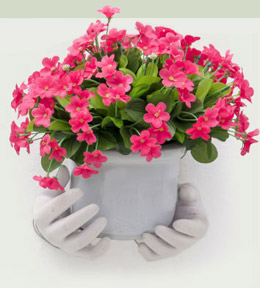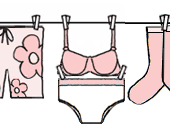
Container Gardening for Beginners
Posted in Healthy Home on May 5, 2014 by FloridaHealth.com staff. Last modified on December 02, 2018. Read disclaimer.
Lack of garden space does not have to prevent you from growing a flower garden. Whether it is a huge planter or a small "color bowl", a garden in a container can be just the thing to add color to the patio or interest to the front entrance. A few simple guidelines will help ensure the success of your container garden.
Container gardening for beginners in 5 steps
1. Best Soil
Do not use garden soil in containers. It will not drain properly and may harbor insects or diseases.
For best results select a good quality "soil-less media." Commercially prepared growing medias usually contain a blend of peat moss, pearlite and vermiculite. They may also contain finely ground pine bark and sand.
+ Free Shipping & Returns on Eligible Items.
(*Amazon's Top 100 list updated hourly.)
2. Cheap Containers
Let your imagination guide you. Anything that will hold soil can be a plant container - as long as it will allow water drainage. When purchasing pots or window boxes make sure they have adequate drainage holes. Buckets, barrels, and other containers can be adapted by drilling holes in the bottom or low on the side.
Best containers or pots for indoor gardening
- To use a decorative container without holes, it is best to plant in an inexpensive plant pot that will fit inside the decorative container. Put an inch of large gravel or even bottle caps in the bottom of the decorative container so the water can drain out of the pot.
- Clay pots are porous and the soil will dry out more quickly. (On the other hand, for gardeners who tend to over water, this may be an advantage.) Non-porous containers will need watering a little less frequently.
- Consider weight if you may want to move the container to a different location. Some new products are available which look like terra cotta, but are much lighter.
- Avoid using black containers in full sun as they will get very hot and dry out too quickly,
- Use "pot feet" if a container with holes in the bottom will be sitting on a solid surface. Purchase pot feet, or simply place some small pieces of wood or gravel under the pot to allow water to drain freely.
- Sanitize previously used containers by scrubbing or soaking in a solution of one part bleach to 9 parts water.
Mixing Containers
Another option is to use groupings of containers. Plant individual plants or groups of plants in separate containers and create added interest with a variety of pots. Use pots of different sizes and shapes. Set a pot on a pedestal to add height. Add, remove, or rearrange containers to vary the display as bloom cycles, seasons or occasions change.
3. What Plants Work Best in Pots
Just as in the landscape, it is important to select plants suited for the location. Plants that need some shade will burn in the sun; and plants that require lots of sun will languish in shade. When selecting several different varieties for a mixed container garden be sure all the plants have the same sun and water requirements.
More Indoor Plant Selection Tips:
- For maximum interest mix 3 or more different plants. Combine different flower colors, textures and plant forms.
- Vary the heights. Choose something tall and spiky, something full and rounded, something low or trailing.
- Let trailing plants flow over the edge of the pot to soften and add volume.
- It's not just about flowers. Many foliage plants are great for adding texture and contrasting colors.
4. Planting Tips
Do not over-crowd the container. Remember, the plants will grow, so leave them enough room to fill in.
Fill the container about three quarters full and water thoroughly. Allow the mix to settle and add more soil if needed. Remove the plants from their nursery pots and loosen roots. Arrange in the pot and fill In with more potting media. Final soil level should be about one inch below the rim of the pot to allow space for watering.
5. Maintenance
Watering:
Watering is usually the most time-consuming chore when maintaining container gardens. This is especially true as plants mature and roots fill the containers. By mid-summer some containers may need to be watered every day. Usually larger containers will require less frequent watering.
Always water thoroughly. Some water should come out of the drainage holes at each watering. (You're more likely to kill a plant with a cup of kindness than a good long drink.)
Fertilizing:
Containers will usually need some supplemental fertilizing during the growing season. Some potting medias contain fertilizer and this should be noted before adding more. Too much fertilizer can burn plants.
Slow release fertilizer pellets are a convenient way to supply fertilizer needs through most of the season. These can be mixed into the media when planting or sprinkled on top of the mix later. Follow label directions for application rates.
Liquid fertilizers, such as fish emulsion, are another popular option. These are usually added to the watering can every few weeks.
Grooming:
Plants may need some attention to keep them looking good all season. Some will bloom more continuously If dead flowers are removed periodically.
Some plants may become too tall or too leggy. Cut them back part way when they start to look straggly. Inspect frequently for insects.
Tiny pests such as spider mites and whiteflies can get out-of-hand quickly. Treat with insecticidal soap, horticultural oil, or a houseplant insecticide spray if needed.
Sources:
Container Gardening, Linda G. Blue, North Carolina Cooperative Extension Agent, Urban Horticulture Buncombe County

 Germiest items in your home | Quiz
Germiest items in your home | Quiz When to wash clothes | Infographic
When to wash clothes | Infographic How to select, ripen and enjoy healthy avocados
How to select, ripen and enjoy healthy avocados Potty training tips for girls and boys
Potty training tips for girls and boys Home & yard mosquito control | Infographic
Home & yard mosquito control | Infographic 9 Beauty secrets to younger-looking skin
9 Beauty secrets to younger-looking skin Dietary needs of adults and older adults
Dietary needs of adults and older adults Can cranberry juice prevent urinary tract infections?
Can cranberry juice prevent urinary tract infections? 9 Foods that are delicious and super nutritious
9 Foods that are delicious and super nutritious What works (and what doesn't) for hangovers
What works (and what doesn't) for hangovers Tips for preventing or treating sunburns
Tips for preventing or treating sunburns Foods that are high in calcium for healthy bones
Foods that are high in calcium for healthy bones Action plan for getting rid of cockroaches
Action plan for getting rid of cockroaches What causes body odor and how to prevent it
What causes body odor and how to prevent it Important tips for preventing heart disease
Important tips for preventing heart disease Ha! Try this funny technique for managing stress
Ha! Try this funny technique for managing stress How to prevent and remove mold and mildew
How to prevent and remove mold and mildew Container gardening ideas
Container gardening ideas What is cholesterol and tips for managing it
What is cholesterol and tips for managing it